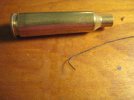longbarrelxp
Well-Known Member
I have used the false shoulder approach for years, even on standard cartridges if the gun has a couple thousandths over minimum headspace. I go .020" to .030" depending on the next size expander I have.
To check brass for thinning in front of the thickened head area, I use a piece of wire with the end cut with dykes (nippers) so I can gently scrape the inside wall and feel for a dip in the inisde wall.
To check brass for thinning in front of the thickened head area, I use a piece of wire with the end cut with dykes (nippers) so I can gently scrape the inside wall and feel for a dip in the inisde wall.

